An Underappreciated Burgundy Wine Region Is Upward Bound: Santenay Reaches New Heights With Six Energetic Growers’ Work in Ten Different ‘Climats’ (6-Bottle Pack $299)
Join Us for Saturday Sips: The Wines of Santenay
Come as you are; come any time that’s convenient for you during our business hours to sample selection from this week’s selections. Our staff will be on hand to discuss nuances of the wines, the terroirs reflected, and the producers.
Traveling south from Chassagne-Montrachet, you crest a hill and suddenly think you’re in Beaujolais—there, silhouetted against the sky, is a picturebook windmill as iconic as Moulin-à-Vent. But it’s the Sorine Mill, the only windmill in Côte de Beaune, built in the early 19th century. It signals that you’ve made your way to Santenay—specifically, to the Premier Cru Santenay-Beauregard.
The most southerly wine-producing commune of the Côte de Beaune, Santenay sits on the extremity of the limestone ridge that is home to Burgundy’s best Pinot Noir sites; as such, Santenay’s output is mostly red. And not merely red, but often descibed as a rustic and wild red that occasionally resembles a Côte du Rhône. Santenay has been likened to the raucous cousin who shows up at a family reunion and introduces you to the dark side.
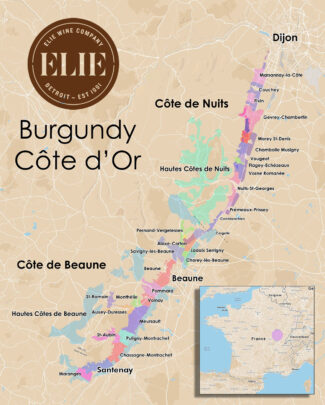
The six young growers featured in this week’s Santenay package are all permutations of that wild country cousin; some have hauled the reputation of their appellation toward elegance and finesse. All have left their mark on the Santenay family to prove that, not only do they belong, they may well represent the future.
The Blooming of Santenay: Long Dismissed, Now a Completely Different Story
Jean-Marc Vincent, president of the Santenay producers association, maintains that the appellation has gotten an undeserved bad rap. It’s a stereotype, he believes, that might be rooted in the fact that Santenay has no Grand Cru vineyards: “And yet, so far in the 21st century, Santenay has produced more than 50 wines rated 90 points or higher in ‘Wine Spectator‘ blind tastings, with retail prices from $30 to well below three figures for our top Crus.”
Although the wines are often referred to as ‘rustic’ rather than ‘elegant’, this is not to say that the wines of Santenay do not capture the poetry of Pinot Noir; Santenay has the soul of Volnay and the body of Pommard. To those who love such earthy, complex Burgundies, Santenay is a marvelously affordable discovery.
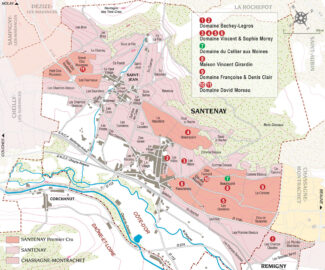
Santenay soils contain less limestone than many of its northerly neighbors, and more marlstone, although proportions vary based on where the vineyard is located—grey limestone can be found up to a height of 1700 feet, while at a thousand feet, oolitic limestone lies over a layer of marl. The ideal exposure for these vineyards is east to southeast.
Jean-Marc Vincent explains: “Santenay has 17 different types of terroirs. You can find terroirs that resemble the Côte de Nuits and others that resemble Meursault or Volnay. Most of the time we prefer to have the perfect balance for Pinot Noir—middle slope with middle-depth soils. We have twelve Premier Crus, 140 hectares over eleven climats.”
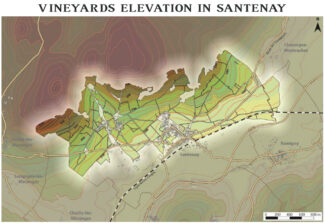
The color, from pale green to brown, increases in intensity according to the inclination value of the slope, from the weakest to the strongest. At the foot of the hill, the slope is very low (0 to 2%) and it graduates, from downstream to upstream, gradually from low (2 to 5%), to moderate (5 to 10%), to strong (10 to 20%, even to very strong (above 20%).
A Complicated Place: Santenay’s Geological Puzzle
There are actually two villages of Santenay, Santenay-le-Haut and Santenay-le-Bas—the high and the low. The Santenay twins punctuate the vineyards and divide them into three distinct parcels, each with its share of Premier Crus: Like the most famous Chardonnay villages in the northern part of the Côte de Beaune, Santenay’s top third is quite marly, overlaid with a layer of gravel. In the middle third, the limestone changes from Argovian—the kind most common in Côte de Beaune—to Bajocian, which is what you find in the Côte de Nuit. In the southern third the limestone is still Bajocian, though here it is richer soil and browner in color.
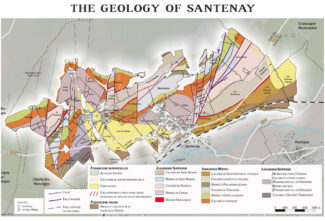
With the Côte-de-Nuit-like soil, it is logical that Santenay vineyards mostly planted to Pinot Noir, and as you might also assume, Santenay’s best whites come from the area bordering Chassagne-Montrachet where Argovian soil reigns supreme.
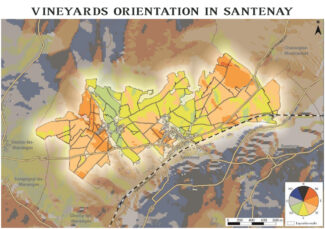
The Premier Crus are oriented mainly to the southeast. The ‘climats’ in communal appellation have variable orientations: those at the bottom of the hillside are oriented to the southeast; those situated on the northern flank of the Combe Saint-Jean have a south/southeast orientation, versus the east for those on the southern flank of the combe.
Domaine Bachey-Legros
Domaine Bachey-Legros attributes its vinous success to low-yielding old vines with deeply-anchored roots that concentrate juice in the grapes. “Power is matched with elegance and the voice of their terroir is loud and clear,” says Bachey-Legros owner Christiane Legros. “Balance is the key.”
The estate includes sites in Santenay, Chassagne-Montrachet, and ‘Les Maranges’ where the vines were planted between 1935 and 1955 and carefully tended by successive generations. Christiane today operates the estate with her sons Lénaïc and Samuel.
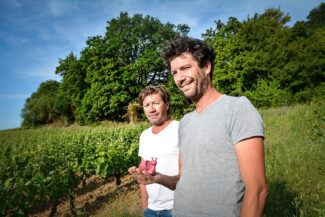
Lénaïc and Samuel Legros, Domaine Bachey-Legros
Samuel speaks further on the magic of older fruit: “Gentle extraction is de rigueur, of course, otherwise the tannins in the naturally powerful fruit is overwhelming. An old vine must be constantly monitored and maintained, nurtured and supported. Compared to a young and vigorous vine that needs keeping under control, an old vine gracefully produces berries of extraordinary concentration, imbued with the ‘goût du terroir’ which its roots have extracted from the very depths of the soil. The fruit is itself small, rich in sugars and highly concentrated.”
2020 – Classical, Voluptuous and Age Worthy
Despite the heat spike that made 2020 the earliest harvest on record, Côte de Beaune wound up producing a classic vintage. Part of the reason was a wet winter and spring, which built up water tables sufficiently to push through drought. 2020 styles are fresh and energetic, serious wines of the type referred to as ‘keepers’, meaning that they are pleasant now but are eager to evolve and improve over several years.
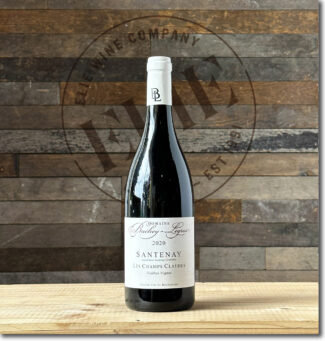 Domaine Bachey-Legros ‘Vieilles Vignes’, 2020 Santenay ‘Les Champs Claudes’ ($45)
Domaine Bachey-Legros ‘Vieilles Vignes’, 2020 Santenay ‘Les Champs Claudes’ ($45)
‘Les Champs Claudes’ is a five-acre climat in Remigny, a commune in the Saône-et-Loire department that produces fantastic wine, but lacks its own appellation. Vines here were planted in 1970. The palate is broad and enveloping, with bright spicy notes and a savory richness that runs through the finish.
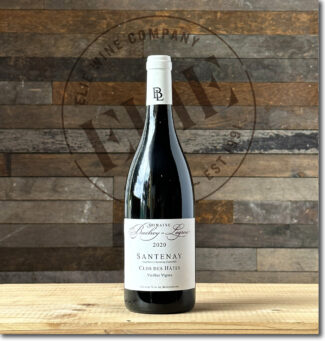 Domaine Bachey-Legros ‘Vieilles Vignes’, 2020 Santenay ‘Clos des Hâtes’ ($49)
Domaine Bachey-Legros ‘Vieilles Vignes’, 2020 Santenay ‘Clos des Hâtes’ ($49)
Love the Hâtes, a 40-acre climat with vines planted 1935; it is considered one of the best parcels in Santenay. Says Christiane Legros: “The fact that the ‘des Hâtes’ vines grow in an enclosed place (a ‘clos’) gives this unique wine all its particularity and specificity. The vines are protected and the soil subjected very little to erosion on well-drained, rather calcareous land on a gentle slope. The terroir has therefore kept all its integrity, and the old vines are perfect in getting the best from it. On the nose, this wine does a balancing act between the depth of fully ripe black fruits and the freshness of red fruits, with lovely hints of spice.”
Domaine Vincent & Sophie Morey
“In my family,” Sophie Morey declares with a smile, “the vines pass from mother to daughter.” Then, Vincent and Sophie Morey, who treat their vineyards as if they were gardens, declare in unison: “Fine wines start with good grapes.”
When wine stars collide, the result is often a synergy of explosive quality. Sophie and Vincent Morey both come from families of winegrowers in Santenay and Chassagne-Montrachet respectively. In 1986, after studies at Beaune’s Lycée Viticole and work experience in St-Emilion in the Bordeaux region, Vincent rejoined the domain led by his father Bernard Morey. That same year Sophie was vinifying her first vintage for the Ménager-Belland domain in Santenay, where she had inherited the tradition of winemaking from her mother.
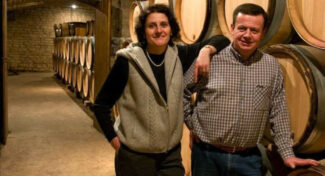
Sophie and Vincent, Domaine Vincent & Sophie Morey
In 2006, the couple set up their own domain, and harvested their first vintage the following year. They reckon that adaptability is key for continued success in the changing climates of central France.
2019 – Concentrated, Vibrant With Immediate Appeal
2019 represented a learning curve for Côte-de-Beaune, as the effects of climate change were so undeniable that everyone, from growers to winemakers to marketers, saw that the future would belong to those who could adapt. The winter was extremely mild but moved into a chilly spring, with April bringing biting frosts that cut deeply into yields. Flowering was uneven due to a cooler than average June and some bunches suffered from millerandage, which again decimated yields. Temperatures warmed up rapidly, and to such an extent that by July and August many of the vines were suffering from heat and drought stress.
The silver lining was that the grapes that survived were concentrated and ripe. The reds in particular are complex, richly fruit-forward and refined, with the best examples likely to cellar well. Winemakers in the Côte-de-Beaune proved their resilience by snatching victory from the jaws of defeat … and de weather.
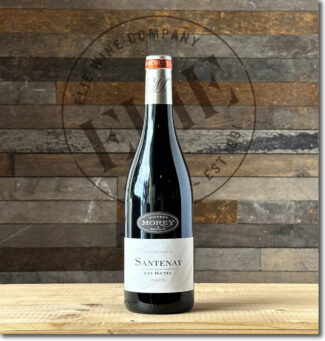 Domaine Vincent & Sophie Morey, 2019 Santenay ‘Les Hâtes’ ($44)
Domaine Vincent & Sophie Morey, 2019 Santenay ‘Les Hâtes’ ($44)
The Moreys control 1.4 acres of this south-facing lieu-dit; the wine is 100% fermented in barrel (45% new wood) and it shows ripe red berries up front followed by powdered chocolate, mocha latte, smoke, honey and caramel on the finish.
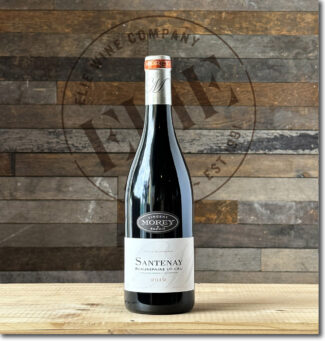 Domaine Vincent & Sophie Morey, 2019 Santenay Premier Cru Beaurepaire ($56)
Domaine Vincent & Sophie Morey, 2019 Santenay Premier Cru Beaurepaire ($56)
Beaurepaire is located above Santenay village and according to local tradition, it was a lover’s lane rendezvous point for young people; hence the name. The 36-acre Premier Cru vineyard lies along the steep slope of Bajocian limestone, just before the hill starts to flatten out around Maranges. It is a fairly isolated plot in terms of Premier Crus, sharing the hillside with La Maladiere. The ruby-hued wine shows notes of cherry, raspberry and undergrowth opening to aromas of mocha and licorice.
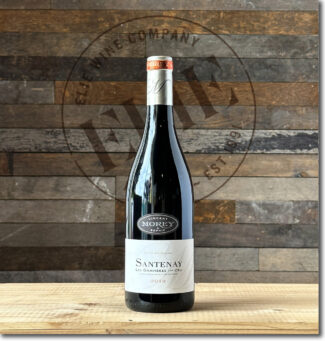 Domaine Vincent & Sophie Morey, 2019 Santenay Premier Cru Les Gravières ($56)
Domaine Vincent & Sophie Morey, 2019 Santenay Premier Cru Les Gravières ($56)
Les Gravières is perhaps the most respected and well-known Premier Cru site in Santenay. Located at the northern end of the village (on the border with Chassagne-Montrachet), the 60-acre vineyard is planted to both Pinot Noir and Chardonnay. It is named for its gravelly soils, which are based on the classic Burgundian limestone-clay and marl. The wine shows ripe red and dark cherry fruit and lots of front-end concentration back by brushing tannins.
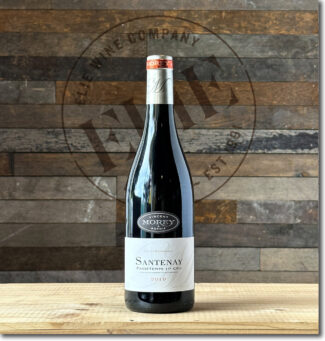 Domaine Vincent & Sophie Morey, 2019 Santenay Premier Cru Passetemps ($56)
Domaine Vincent & Sophie Morey, 2019 Santenay Premier Cru Passetemps ($56)
Passetemps is essentially a continuation of Gravières, planted on white marl, and is considered one of the more underrated Premier Cru vineyards in Santenay. Passetemps wines tend to bend towards crisp red fruit flavors wreathed in velvety tannins. In this textbook Passetemps, cranberry and pie cherries stand out behind rose hips, peonies and white pepper.
A Window to The Past – With Five-Bottle Package $327
Wine is evolution from vine to cellar and from bottle to glass and the maturation process is a complicated one. The science—involving the ratio of sugars, acids and phenolics and the slow polymerization of tannins—is as dry as a dusty old flagon of Gevrey-Chambertin. But even the most carefully-kept bottles of the most age-friendly wine have an apex, a window of optimal drinkability wherein the all the magic that is likely to happen has already happened. For a red Burgundy from a solid (but not great) vintage, that window hovers at around a decade.
The wines from this package represent various mature and maturing vintages from four top producers.
Domaine du Cellier aux Moines
Overlooking one of Givry’s historic Premier Crus, the Cellier aux Moines was magnificently restored by Catherine and Philippe Pascal and their three children. Pascal is the former CEO of Veuve Clicquot and the Moët Hennessey Group, and after retiring from the company, he began a search throughout Burgundy for a restoration project, ultimately settling on overgrown vineyard slopes of Givry’s ancient monastery, La Ferté Abbey, which had produced wine in the region going back nine centuries.
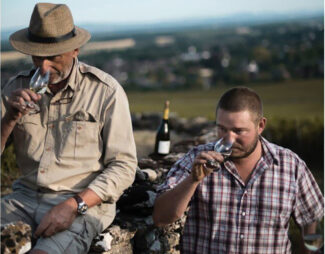
Philippe Pascal and Viticulturist / Winemaker Guillaume Marko, Domaine du Cellier aux Moines
In 2015, Guillaume Marko joined the Domaine as head of vineyards and winemaking operations. Holding a DNO (Diplôme National d’œnologie) from Dijon University, Guillaume trained during few years in famous wine estates of Côte de Nuits, including Domaine de la Romanée-Conti.
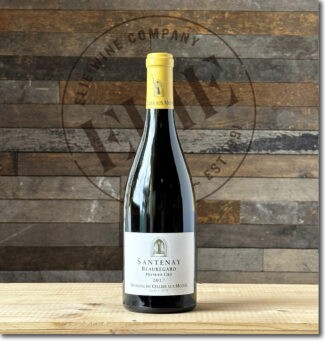 Domaine du Cellier aux Moines, 2017 Santenay Premier Cru Beauregard Blanc ($62)
Domaine du Cellier aux Moines, 2017 Santenay Premier Cru Beauregard Blanc ($62)
This 100% Chardonnay comes from a 0.6-acre parcel of one of the top Santenay vineyards. With its generous, warm character, the wine is rich, with vanilla highlights acting as a reminder that it was wood-aged while the palate flexes with lemon oil, hazelnut and baked apples.
Maison Vincent Girardin
Based in Meursault, Vincent Girardin (the domain’s founder) originally farmed around 50 acres while acting as a négociant, buying fruit from growers who adhered to a code of practice upon which he insisted, including higher trellising for better photosynthesis and avoiding the use of herbicides and insecticides. When Vincent Girardin sold the business in 2012, Éric Germain—his winemaker since the early 2000s—along with a team of nine, ensured that Girardin’s winemaking philosophy and purity of expression would continue.
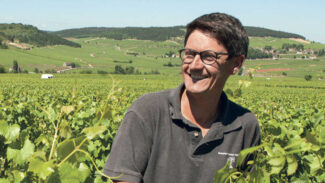
Éric Germain, Maison Vincent Girardin
2017 – Supple and Accessible
For much of the Côte de Beaune, 2017 represented a ‘return to normal’ with volumes nudging on generous. This was a boon to vignerons who saw their crops damaged by frosts and hailstorms in the previous four vintages. Grapes were healthy and free from rot for most of a dry, rather humid season, and the timely harvest led to a consistent and delicious vintage overall, especially for whites. They have no inherent fragility and possess the fundamental structure to age.
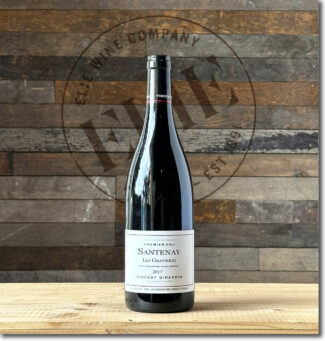 Vincent Girardin, 2017 Santenay Premier Cru Les Gravières ($51)
Vincent Girardin, 2017 Santenay Premier Cru Les Gravières ($51)
The gravelly marl for which Les Gravières is known creates a wine that Éric Germain describes as ‘well-built and developing a floral bouquet. The mouth is often very large with bold tannins. This wine reminds us of the Grand Crus from the Cote de Nuits.’
We’ll add the following tasting notes: A fruit-driven palate of sour cherry, forest floor and mushrooms.
Domaine Françoise & Denis Clair
It’s a familiar story among a newer generation raised among stalwarts: The Clair family had owned parcels in the area for generations but sold most of their production to négociants. Denis Clair created the domain in 1986 and set out to bottle his own wine as well as grow grapes.
Although the winery is in Saint-Aubin (where Denis owns a few parcels of Chardonnay) he farms 23 acres of Santenay Pinot Noir. These wines, with nearly full destemming and an extended cold maceration, show characteristic richness while retaining a sense of elegance. In part, it’s cellar technique and in part, it’s terroir—the soil here is ‘terre blanche’ (crushed limestone along with some clay) but deeper, and with a higher percentage of clay than those of Saint-Aubin.
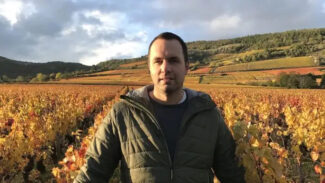
Jean-Baptiste Clair, Domaine Françoise & Denis Clair
In 2000, Denis’ son Jean-Baptiste joined the family business to work the vines and today is responsible for making the white wines. Under his guidance, the domain has embraced a more holistic approach to viticulture. He says, “No herbicides or pesticides are employed. The soils are worked with a plow so that we can limit or eliminate any weed killers. An effort is made to work as organically as possible, although in very rainy years like 2012 and 2013, some synthetic sprays are employed. We ferment on indigenous yeasts; the reds are punched down and pumped over. All of our wines go through malolactic fermentation. The whites are fined and lightly filtered and the reds are lightly filtered if necessary. Only one bottling is done per year at the domain, normally 15 to 18 months after the harvest. And the sulfur dose is low: 20-25 mg/l for the reds and 30-35 mg/l for the whites.”
2015 – Ripe, Structured and Deeply Fruited
The 2015 vintage was extraordinary throughout the Côte d’Or, and the reds are truly great: rich, powerful and statuesque but almost universally underpinned by juicy acidity.
The growing season was carefree, with no frost and only a single hail storm. The summer was dry and extraordinarily hot, but the previous winter had replenished the water tables and welcome August rains relieved the drought enough that an orderly and timely harvest occurred, resulting in a vintage that some consider legendary.
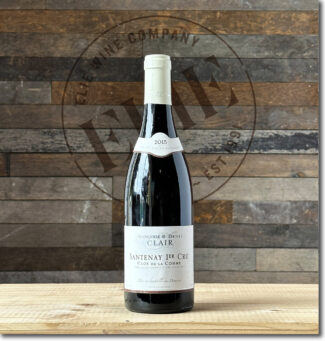 Domaine Françoise & Denis Clair, 2015 Santenay Premier Cru Clos de la Comme ($68)
Domaine Françoise & Denis Clair, 2015 Santenay Premier Cru Clos de la Comme ($68)
At 53 acres, the vineyard La Comme is quite large, but it does not all qualify as Premier Cru; the upper part is classified at the Village level. The ‘Clos’ is the core of the site, and is directly adjacent to Chassagne-Montrachet. To make this wine, the grapes are harvested by hand and fermented with 10-20% of their stems intact. Aging takes place in oak barrels (25% new) and the wine is bottled after 12 months. It shows an intriguing and mature nose of mushrooms, forest floor and red berries. On the palate, the flavors remain fresh and subtle, cherry and strawberry complemented by lingering acidity.
Domaine David Moreau
After wine school in Beaune and Dijon and internships at Domaine de la Romanée-Conti and Domaine Hubert Lamy in Burgundy, Château de Beaucastel in Châteauneuf-du-Pape and Neudorf Vineyards in New Zealand, David Moreau took over the family domain, and produced the 2009 vintage as his own.
The lessons he learned are as fundamental as they are vital: “My only aim is to explain each terroir, to get the best out of each plot.”
The winemaking passion skipped a generation; David’s father did not want to run the estate, so David’s grandfather, who was 80 years old when David took over, hung on and waited. By then, the younger Moreau had already staked his claim, choosing twelve acres to bottle under his own name, producing seven wines. He also makes the wine from the remaining vineyards but under the Domaine Jean Moreau label where he adheres to the guidelines of his grandfather.
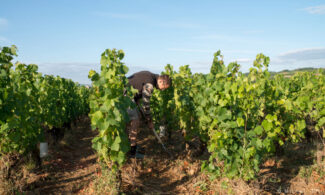
David Moreau, Domaine David Moreau
Why the split? “I have a personal vision,” he says. “I learned a lot from working at these other estates opened my mind and eventually I understood what I wanted to do myself, which is not necessarily the same things my grandfather wants. He is ancien régime. In New Zealand I saw a very different way of making wine. It was a bit more scientific. Not as much feeling. In Burgundy you feel what you are doing. It is not the analysis results that tell you what to do.”
2011 – Light Colors, Expressive Aromas and Elegant
A somewhat spotty vintage, so it pays to know your producer. The spring was warm, and flowering was early, at the end of May, promising an early harvest. Then the climate started playing its usual tricks with a cool early summer with temperatures soaring in late June causing sunburn on exposed bunches. July was actually cooler than April, and hail on July 12 smashed into the southern Côte de Beaune. In late July the weather improved and it stayed warm into August, but storms and more very hot weather later in the month both slowed the maturation and caused some dilution within the grapes. Mildew followed. Growers wrestled with the crucial decision on when to harvest and the ones who bet correctly (like David Moreau) produced some amazing wines.
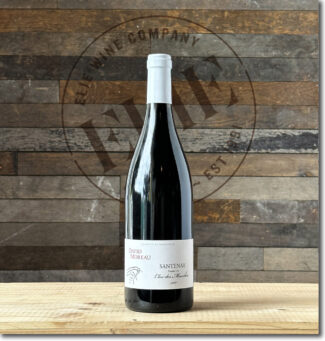 Domaine David Moreau, 2011 Santenay Premier Cru Clos des Mouches ($78)
Domaine David Moreau, 2011 Santenay Premier Cru Clos des Mouches ($78)
The Clos des Mouches is the smallest Santenay Premier Cru, a quarter-acre squeezed in between Passetemps, Beauregard and Clos Faubard. Most of it belongs to Domaine David Moreau. Vines were planted in the 1960s, and compared to Moreau’s Rousseau, this is an exposition of grace and finesse with the initial strawberry notes morphing elegantly into sweet dried fruit and fragrant leather.
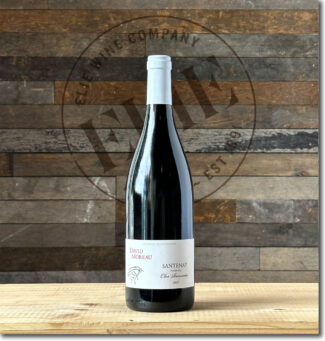 Domaine David Moreau, 2011 Santenay Premier Cru Clos Rousseau ($68)
Domaine David Moreau, 2011 Santenay Premier Cru Clos Rousseau ($68)
Clos Rousseau is a Premier Cru umbrella covering three neighbouring vineyards at the western end of Santenay. Rousseau soils are heavier and slightly richer than elsewhere, and based on Bajocian limestone closer to the terroirs of the Côte de Nuits, 20 miles to the north. Moreau’s Rousseau shows like a mature stallion, a graceful florality and luminous glow remaining, but allowing the animal hide and sous bois that mark the evolution of a delicately crafted Pinot Noir to shine through.
- - -
Posted on 2023.07.22 in Santenay, France, Burgundy, Wine-Aid Packages
Featured Wines
- Notebook: A’Boudt Town
- Saturday Sips Wines
- Saturday Sips Review Club
- The Champagne Society
- Wine-Aid Packages
Wine Regions
Grape Varieties
Aglianico, Albarín Blanco, Albillo, Aleatico, Alicante Bouschet, Altesse, Arbanne, Aubun, Auxerrois, barbera, Beaune, Bonarda, Cabernet Franc, Cabernet Sauvignon, Caino, Caladoc, Calvi, Carcajolu-Neru, Carignan, Chablis, Chardonnay, Chasselas, Chenin Blanc, Cortese, Corvina, Corvinone, Cot, Erbamat, Ferrol, Fiano, Frappato, Friulano, Fromenteau, Fumin, Garganega, Garnacha, Gewurztraminer, Godello, Grenache, Grolleau, Jacquère, Juan Garcia, Lambrusco, Lladoner Pelut, Loureira, Macabeo, Macabou, Malvasia, Malvasia Nera, Marsanne, Melon de Bourgogne, Mencía, Merlot, Mondeuse, Montanaccia, Montepulciano, Morescola, Morescono, Moscatell, Mourv, Mourvèdre, Muscadelle, Nebbiolo, Nero d'Avola, Parellada, Pecorino, Petit Meslier, Petit Verdot, Pinot Auxerrois, Pinot Blanc, Pinot Gris, Pinot Meunier, Pinot Noir, Poulsard, Prieto Picudo, Rondinella, Roussanne, Sangiovese, Sauvignon Blanc, Savignin, Semillon, Souson, Sparkling, Sumoll, Sylvaner, Syrah, Tannat, Teroldego, Timorasso, Trebbiano, Trebbiano Valtenesi, Treixadura, Trousseau, Ugni Blanc, vaccarèse, Verdicchio, Vermentino, Viognier, Viura, Xarel-loWines & Events by Date
- May 2024
- April 2024
- March 2024
- February 2024
- January 2024
- December 2023
- November 2023
- October 2023
- September 2023
- August 2023
- July 2023
- June 2023
- May 2023
- April 2023
- March 2023
- February 2023
- January 2023
- December 2022
- November 2022
- October 2022
- September 2022
- August 2022
- July 2022
- June 2022
- May 2022
- April 2022
- March 2022
- February 2022
- January 2022
- December 2021
- November 2021
- October 2021
- September 2021
- August 2021
- July 2021
- June 2021
- May 2021
- April 2021
- March 2021
- February 2021
- January 2021
- December 2020
- November 2020
- October 2020
- September 2020
- August 2020
- July 2020
- June 2020
- May 2020
- April 2020
- March 2020
- February 2020
- January 2020
- December 2019
- November 2019
- October 2019
- September 2019
- August 2019
- July 2019
- June 2019
- May 2019
- April 2019
- March 2019
- February 2019
- January 2019
- December 2018
- November 2018
- October 2018
- September 2018
- August 2018
- July 2018
- June 2018
- May 2018
- April 2018
- March 2018
- February 2018
- January 2018
- December 2017
- November 2017
- October 2017
- September 2017
- August 2017
- July 2017
- June 2017
- May 2017
- April 2017
- March 2017
- February 2017
- January 2017
- December 2016
- November 2016
- October 2016
- September 2016
- August 2016
- July 2016
- June 2016
- May 2016
- April 2016
- March 2016
- February 2016
- January 2016
- December 2015
- November 2015
- October 2015
- September 2015
- August 2015
- July 2015
- June 2015
- May 2015
- April 2015
- March 2015
- February 2015
- January 2015
- December 2014
- November 2014
- October 2014
- September 2014
- August 2014
- July 2014
- June 2014
- April 2014
- March 2014
- February 2014
- January 2014
- December 2013
- November 2013
- October 2013
- September 2013
- August 2013
- July 2013
- June 2013
- May 2013
- April 2013
- March 2013
- February 2013
- January 2013
- December 2012
- November 2012
- October 2012
- February 2004
Search



